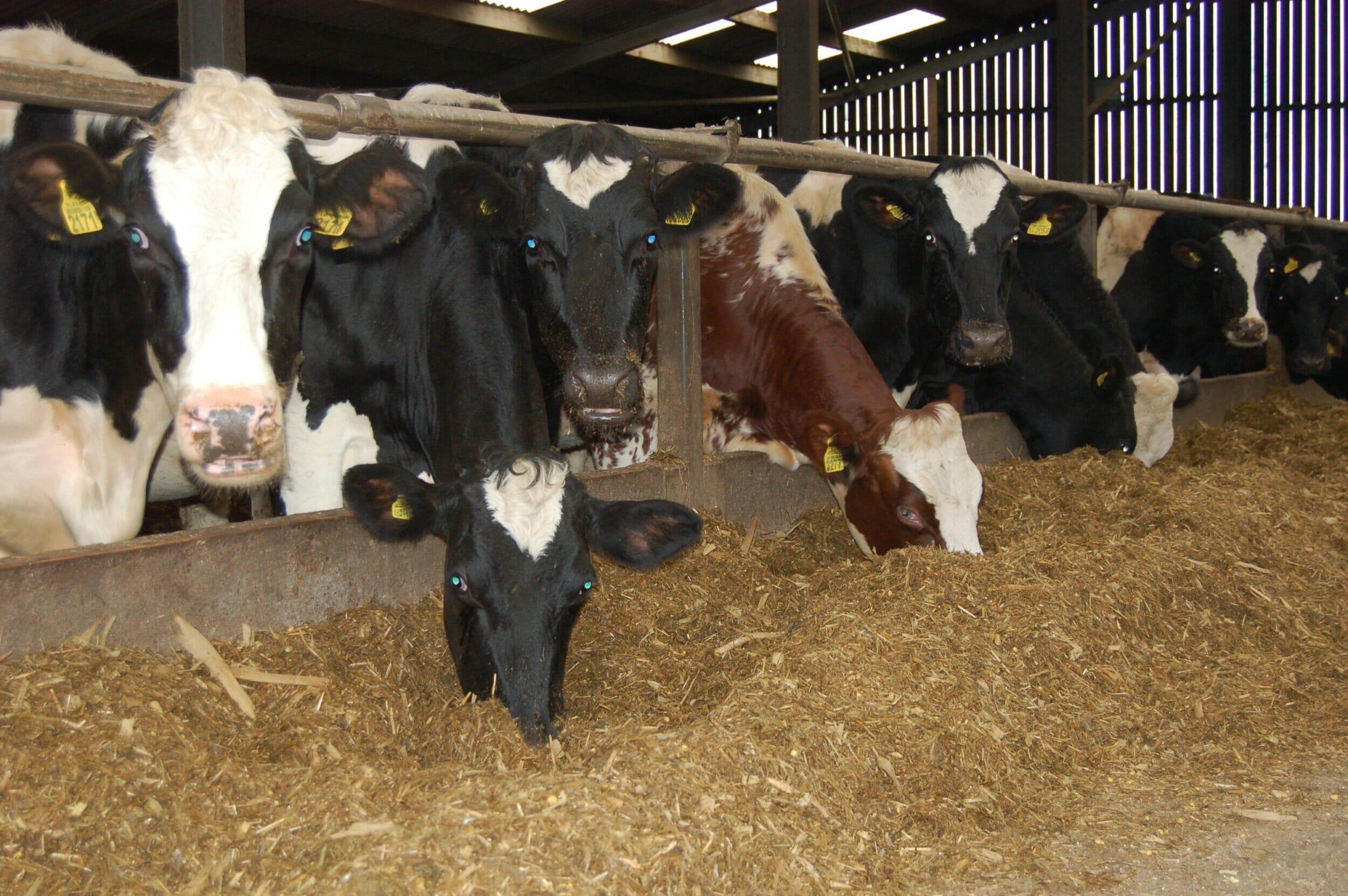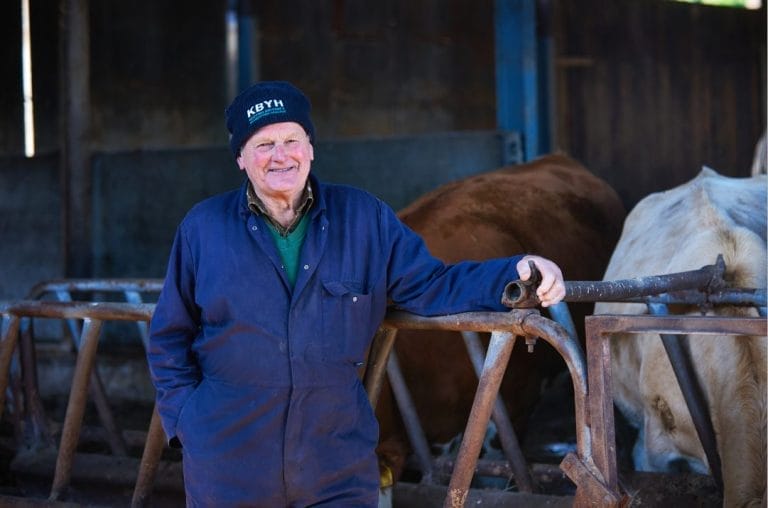Jonathan Evans is the third generation of the family to milk cows at Berry Hill Farm, near Newport in Pembrokeshire, where he farms with his grandparents Hayden and Dilys, his father Mark and Uncle, Colin. The farm is 154ha of owned and rented land, right on the coast.
They run a herd of 220 all year-round calving cows with typically 185 cows in milk. They are 85% pedigree Holsteins with 15% crossbreds. They are currently averaging 8150 litres. It is a relatively young herd as a large number of cows were sold in 2019, and yields are increasing as the herd matures.
The farm is also carrying 250 youngstock as it is under TB restrictions. Heifers calve down at 21-25 months old.
 The herd grazes for as long as conditions allow, usually from late April until mid-October. Being mainly sandy loams and so close to the sea, the farm is prone to drying out so summer grass growth can be an issue. In the winter, the cows are currently housed as a single milking group, but a new building is due to be available from February. This will allow cows to be housed in two groups of open, higher yielders and in calf, low yielders.
The herd grazes for as long as conditions allow, usually from late April until mid-October. Being mainly sandy loams and so close to the sea, the farm is prone to drying out so summer grass growth can be an issue. In the winter, the cows are currently housed as a single milking group, but a new building is due to be available from February. This will allow cows to be housed in two groups of open, higher yielders and in calf, low yielders.
Winter feeding had been based on multicut grass silage and some wholecrop, but in 2021 they made the move back into maize.
“We had grown maize about eight years ago,” Jonathan comments. “We had grown some good crops but had problems with badger damage. However, we decided to give it another go, in particular as we wanted to try and improve milk quality which is important in our Glanbia contract.
“We decided to grow 32 hectares. We wanted early maturing varieties as we needed the crop available to feed as soon as possible, but also as this would allow us to follow up with either a grass ley or forage rye.”
They decided on two varieties, including LG’s Gema which was chosen in discussion with Wynnstay agronomist Lawrence Cozens, who explains that agronomically, Gema would fit the bill and he had grown it successfully previously in the area.
“Gema is an ultra-early maturing variety (FAO 150) with a shorter growing season and good early vigour, making it ideal for a short season rotation,” Mr Cozens explains. “It delivers high dry matter yields and is capable of producing a high starch forage, which is what Jonathan was looking for.
“It was particularly important to be able to drill successor crops and to avoid having bare soils which can lead to increased compaction, soil run-off and nutrient loss.”
 The maize land received a significant amount of slurry and manure before ploughing. All the maize was drilled in late April after first cut grass and having waited for soils to reach the optimum 8°C at drilling depth. Fertiliser was applied to the seedbed and a pre-emergence herbicide was used with a follow-up spray based on specific problems.
The maize land received a significant amount of slurry and manure before ploughing. All the maize was drilled in late April after first cut grass and having waited for soils to reach the optimum 8°C at drilling depth. Fertiliser was applied to the seedbed and a pre-emergence herbicide was used with a follow-up spray based on specific problems.
Mr Cozens comments that the Gema got away particularly quickly as a result of delaying drilling and established strong plants quickly. He had planned to use a foliar fungicide, biostimulant and foliar plant nutrients at tussling, but the feeling was that the Gema had got too tall.
Throughout the growing season, Jonathan Evans commented that the Gema was ahead of the other variety and when ready to harvest, was standing 3 metres high and with large cobs.
“We harvested in late September as soon as the crop was ready because we had a good harvest window. We could possibly have left it a bit longer as the plant was still quite green, but this was not a problem. Harvesting early also meant we could sow 12ha of forage rye for dry cow feed.
“On average, we yielded at 42t/ha with the Gema yielding highest at 44t/ha. The analysis has been good at 33.2% dry matter, 32% starch, 83.7% starch degradability and 11.4MJ ME. We started feeding the day after harvest and began to see improvements immediately.”
Diets at the farm are developed by Wynnstay Head of Dairy Services David Howard who says adding maize silage has had significant benefits to performance. He comments that it has helped make better use of this winter’s grass silages which have generally been variable and below average quality.
“Feeding two forages can help increase total forage dry matter intakes and better balance the grass,” he comments. “But the biggest benefit has been in helping boost milk quality, particularly protein.
“The energy content and the bypass starch have helped drive rumen fermentation and we saw an increase in milk quality as soon as the maize was introduced.”
“The base ration comprises of 25kg first cut silage, 20kg maize silage, 1.0kg of a sugar-based molasses, 0.75kg chopped straw and 3kg of a balancer blend. The cows are then fed to yield in the parlour with an 18% high energy nut.
In September milk quality was running at 4.0% fat and 3.15% protein. In early October it has increased to 4.49% and 3.3% respectively and averaged 4.58% and 3.33% for the month. In November the averages were 4.55% fat and 3.42% protein. In total the increased milk quality is worth around 1ppl extra milk price. Milk urea has fallen from 0.028% to 0.024% indicating better protein utilisation in the diet.
Milk yields have also risen. The herd is now averaging 29.8 litres compared to 26.0 litres in September, with cows less than 150 days in milk averaging 34 litres.
“Maize will also make an excellent buffer feed when cows are grazing, with the starch helping to complement the high protein in spring grass,” Mr Howard continues.
 Based on the improved performance, Jonathan Evans is keen to grow more maize in 2022. He is planning to grow 49 hectares and at least 75% of the crop will be Gema.
Based on the improved performance, Jonathan Evans is keen to grow more maize in 2022. He is planning to grow 49 hectares and at least 75% of the crop will be Gema.
He says maize is clearly an excellent feed and is definitely having an economic impact. In addition to the milk quality increases resulting in a better milk price, purchased feed costs per litre have come back from 9.3ppl to 6.3ppl.
He comments that maize is less weather dependent that grass, particularly on a coastal farm.There are fewer variables affecting how it performs, and he can be confident of at least 37t/ha of a high energy and consistent feed to use as the base for diets.
“With substantially higher fertiliser prices, maize has the added benefit of being a lower user of bagged fertiliser than grass and it is all applied early in the season when uptake is greater and not affected by fields drying out.
“I hope to grow enough to feed the cows through the winter and also for buffer feeding. If possible, I would like to feed some maize to youngstock,” he adds.



































